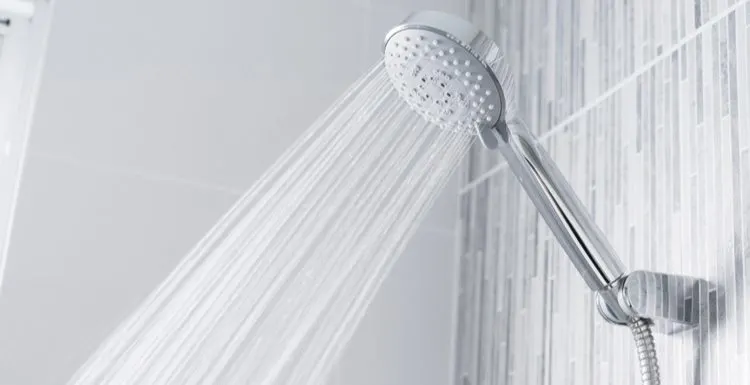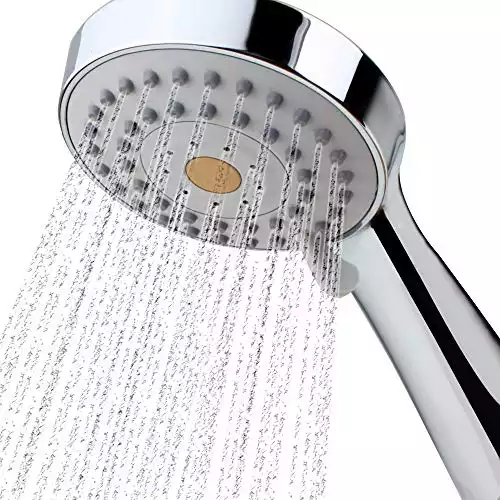Do you need to know how to increase water pressure in the shower? You’re in the right place.
We’ll tell you everything you need to know about the steps to take and things to consider when adjusting your water pressure.
How to Increase Shower Water Pressure
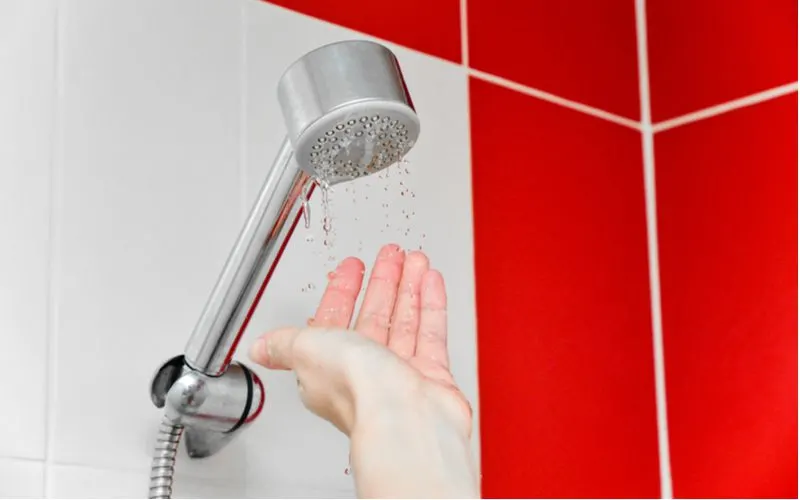
Kryuchka Yaroslav/Shutterstock
There are a couple of ways to fix low water pressure in your shower.
First, you’ll need to identify what’s causing the problem. None of these methods are complicated, but there are quite a few of them!
We’ll walk you through what you need to do to fix a low-pressure shower.
- Clean your shower head
- Check for a flow restrictor
- Change your shower head for a low-pressure one
- Turn your main water valve on completely
- Check for kinks (in a flexible hose, not if you have pipes)
- Check for leaks
- Check your water heater
- Install a shower pump
- Turn off other appliances when showering
Want more detailed troubleshooting steps?
You’re in luck — I used to work in the plumbing department at Menards in college, so I know a thing or two about increasing water pressure.
Join me as I walk you through the steps to try in detail below.
How to Improve Water Pressure in 9 Steps
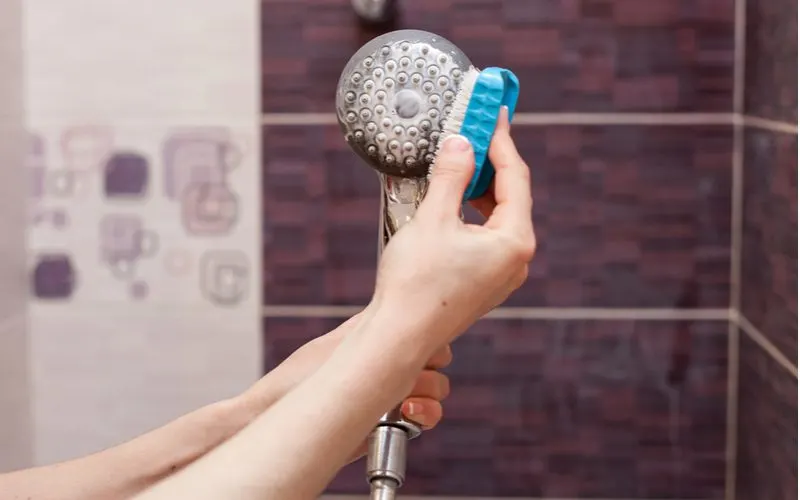
Brizmaker/Shutterstock
Improving the water pressure in your shower isn’t tricky, but there are a lot of potential culprits that cause low water pressure.
We’ll explain in detail all the ways you can improve your shower’s water pressure.
Step 1: Clean Your Shower Head
We’ll start with the simplest and least expensive method first: clean your current showerhead.
Over time, sediment and other scum can build up in your shower head, and that will significantly slow your water flow.
Unscrew the showerhead and scrub it with soap and water. You don’t need special tools for this, but you can use a toothbrush for the tiniest holes if you like.
If you can see significant buildup, you can submerge your showerhead in a bowl of white vinegar and let it soak overnight for at least 8 hours. It will be completely cleared by morning.
Step 2: Check for a Flow Restrictor
You should still clean your shower head, but while you do so, look up your model online and see if it has a flow restrictor.
Flow restrictors were introduced to showerhead manufacturing as part of the National Energy Act to help conserve water and lower your bills.
Not all areas have equal water flow. If you live in a neighborhood with low water flow, then a water restrictor isn’t just useless; it’s seriously reducing your water.
Removing it may be your only option. The directions for this step will vary based on the showerhead you have.
But once you’ve removed the shower head from your shower and carefully removed both the gasket and shower screen (if you have one), you should be able to pry out the flow restrictor with just a paperclip or other small leverage.
Keep in mind that removing this could increase your water bill, so it may not be your first choice.
Step 3: Change Out Your Shower Head for a Low-Pressure One
If cleaning didn’t do the trick, you might have a plumbing problem rather than a cleanliness one. If your low water flow isn’t severe, you could try replacing your showerhead with one made for low-pressure households.
This doesn’t have to be expensive. There are reasonably priced shower heads designed to put out a high-pressure jet of water.
Look for showerheads with high pressure in the name or with multiple settings.
For many people, simply replacing an old showerhead will drastically improve water pressure, but this won’t be a fix for significant plumbing issues.
Step 4: Check Your Main Water Valve
This is the first thing you should check if your water flow problems began after you’ve had work done in your home.
Maintenance workers may forget to turn the main water line back on, or they may forget to open the valve completely.
The main water valve will likely be located in your home’s basement and usually has a colored lever.
If it isn’t turned all the way, turn it, and then check your water pressure. If you find that the lever is exceptionally rusty or difficult to move, you should call a plumber. Forcing it open could damage your water pipes.
Step 5: Check for Kinks
If you have a flexible hose shower rather than a fixed head shower, you should check the hose for kinks.
If you find damage to your hose, like dents or twists, you may need to untwist your hose or get a replacement.
Step 6: Check for Leaks
If you suspect a plumbing problem is the cause of your low water pressure, you can quickly check for leaks yourself.
Is the low water pressure only a problem in your shower? Or is it also a problem in your kitchen, sinks, garden hose, or anywhere else you have water?
If you have low-pressure problems in multiple places, check your home for leaks. It’s vital that you find leaks because they can cause damage to your whole plumbing system.
Water buildup can ruin surfaces, too. If you find a leaky pipe, you can temporarily fix it with epoxy putty.
However, you should call a plumber to assess the damage and find out if anything else needs fixing.
Step 7: Check Your Water Heater
Do you only have pressure problems when using your hot water? Then your water heater may be the culprit.
If your shower’s water pressure is fine when you’re using cold water, then you should look at your water heater.
There are two things you might have to do to your water heater: open the shut-off valve or flush the heater. Your water heater has a shut-off valve. If it’s closed, open it! That should fix your problem.
If the valve is already open, then try flushing your water heater. It’s possible that residue and other dirt buildups have clogged the tank on your water heater and the pipes it uses to feed your shower.
Drain your water heater to flush out all the sediment. This should effectively remove the buildup in the heater and return your hot water pressure to normal.
Here are the steps below:
- Turn both your hot and cold water off (to prevent the tank from being filled)
- Let the water in the tank cool (about 2 hours)
- Attach a hose to the drain valve on the side of the tank (place the other end in a drain or bucket)
- Turn on the hot water around your home and let it run to stop a vacuum from forming in your pipes (there shouldn’t be a lot)
- Turn on the drain valve; you’ll probably need a screwdriver
- After it drains completely, turn the cold water back on, then turn the heater back on
Step 8: Install a Shower Pump
If none of these methods have worked for you or match your problem, you can try installing a shower pump.
If you’re on a budget, this will likely be your last resort, as installing a shower pump can be expensive.
The pump itself and the installation cost money; you will probably need a professional plumber to do the installation.
A good pump can cost up to $600, and the professional installation will be another couple of hundred, depending on where you live. The shower pump is fitted directly onto your home water system.
Water will pass through it and get a boost, increasing the flow rate through your shower. Depending on your system, you could try to do this yourself.
But if you don’t have a lot of experience, you should hire a professional or risk hurting your plumbing.
Step 9: Turn Off Other Appliances While Showering
Turning off other appliances while showering is the simplest thing you can try, but it won’t work if you have other plumbing issues.
Make sure you aren’t running your washing machine or dishwasher before stepping into the shower.
With the other appliances turned off, you may see increased water pressure in your shower.
Things to Consider
Now that you know what to look for, here are some things to keep in mind when trying to increase your shower’s water pressure:
- Check if you have water flow problems in one room or throughout your home. The first is a problem with your shower, and the second is a problem with your plumbing.
- Some of these methods will cost more than others. For example, removing a flow restrictor will increase both water pressure and bills.
- You should know what work you can and can’t do yourself. It’s nice to save money, but if you’re inexperienced, hire a plumber, or you can pay a lot in self-inflicted damage.
Frequently Asked Questions
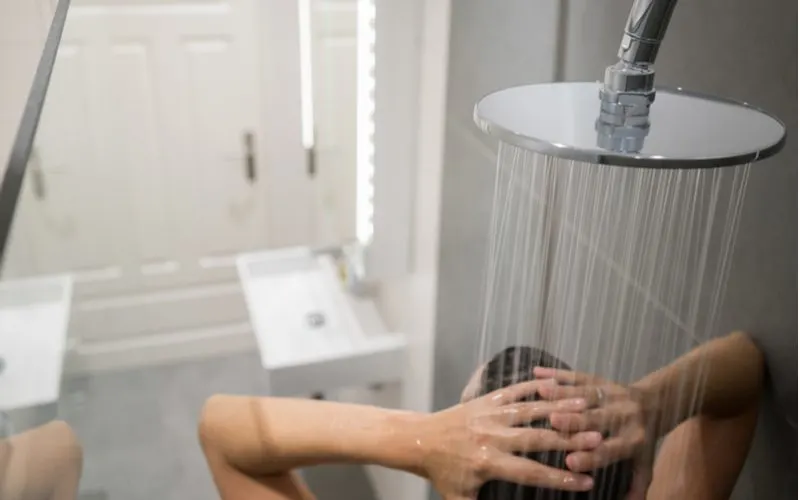
Stockfour/Shutterstock
Still stuck figuring out how to increase water pressure in your shower? Here are a few tips that may help.
How do I fix low water pressure in my shower?
You’ll need to identify the cause first. Is it a plumbing problem? Sediment buildup? Old shower head? Try the most straightforward fixes first, like cleaning your shower head, and then look for more serious problems if that doesn’t work.
Why is my shower so weak?
You may have faulty plumbing, sediment buildup in the showerhead or water tank, or a leak somewhere. Your neighborhood may have restricted water flow too.
Can you increase your own water pressure?
There are many ways to help increase your water pressure. You can clean your shower head or purchase a new one that’s made to increase water pressure. There are more expensive methods like hiring a plumber to install a water pump or search for plumbing damage.
Can a shower head increase water pressure?
Some showerheads are designed to deal with low-pressure water. You can try replacing your shower head with such a model and this can fix your flow problems.
Why is water pressure low in one bathroom?
If the water pressure is low in one room and not others, this can be a problem with the pipes in that bathroom. Search for leaks and kinks and call a plumber. You may also need to clean your faucets or showerhead to remove sediment buildup.
So, How to Increase Shower Water Pressure?
The answer to this question will change based on the cause of your low water pressure.
Try the most uncomplicated methods first (cleaning or changing your shower head or checking the main water valve) before looking at more complex solutions like hiring a plumber.

